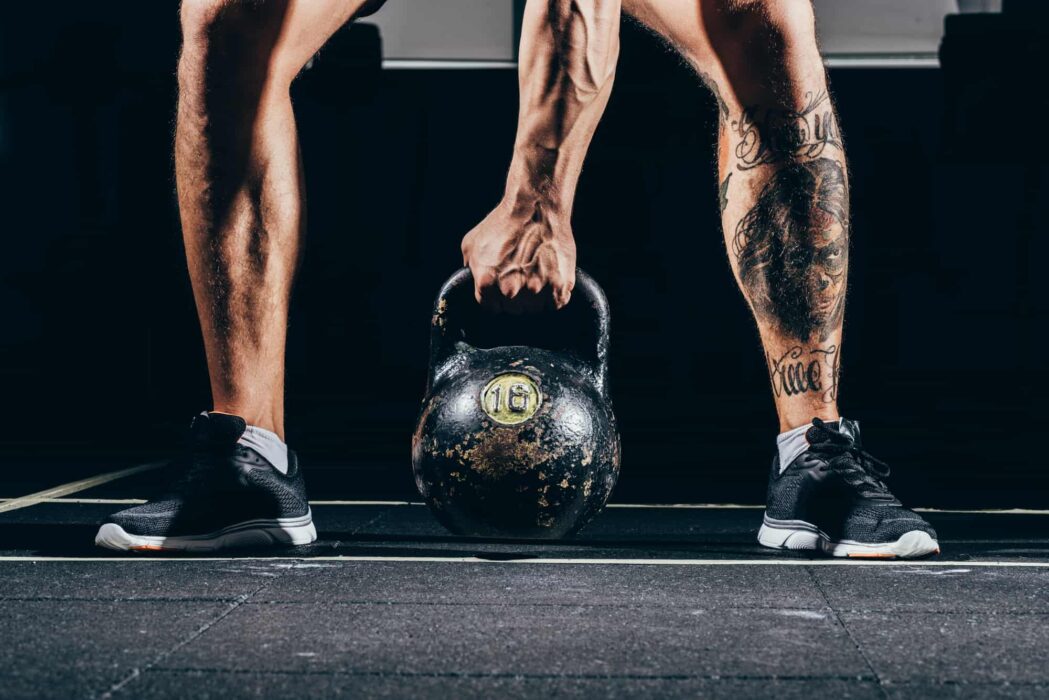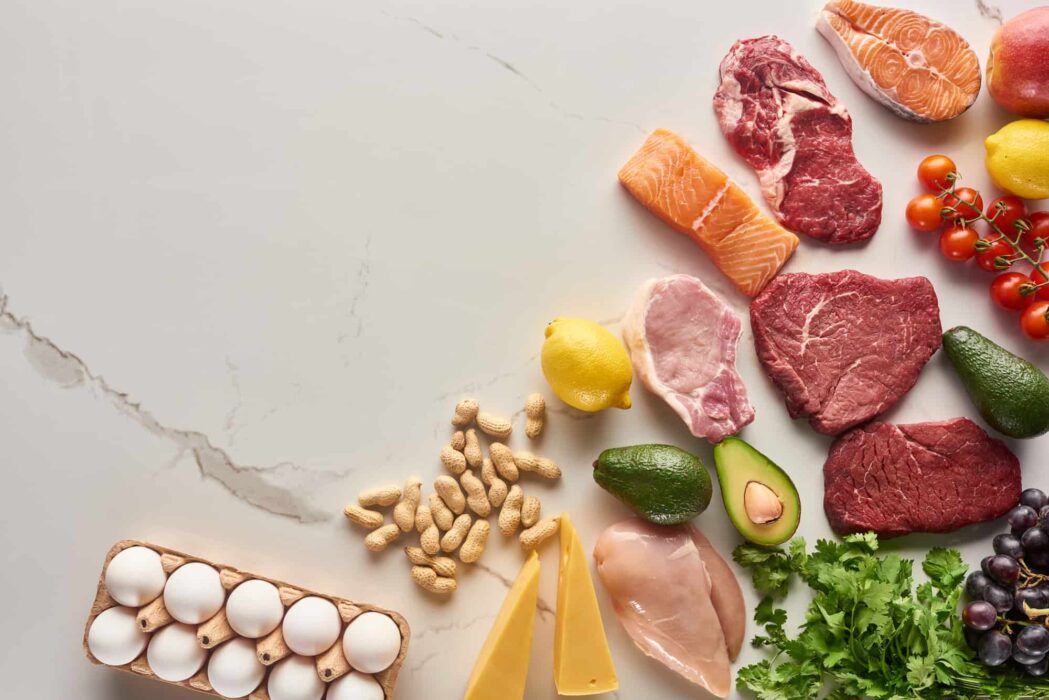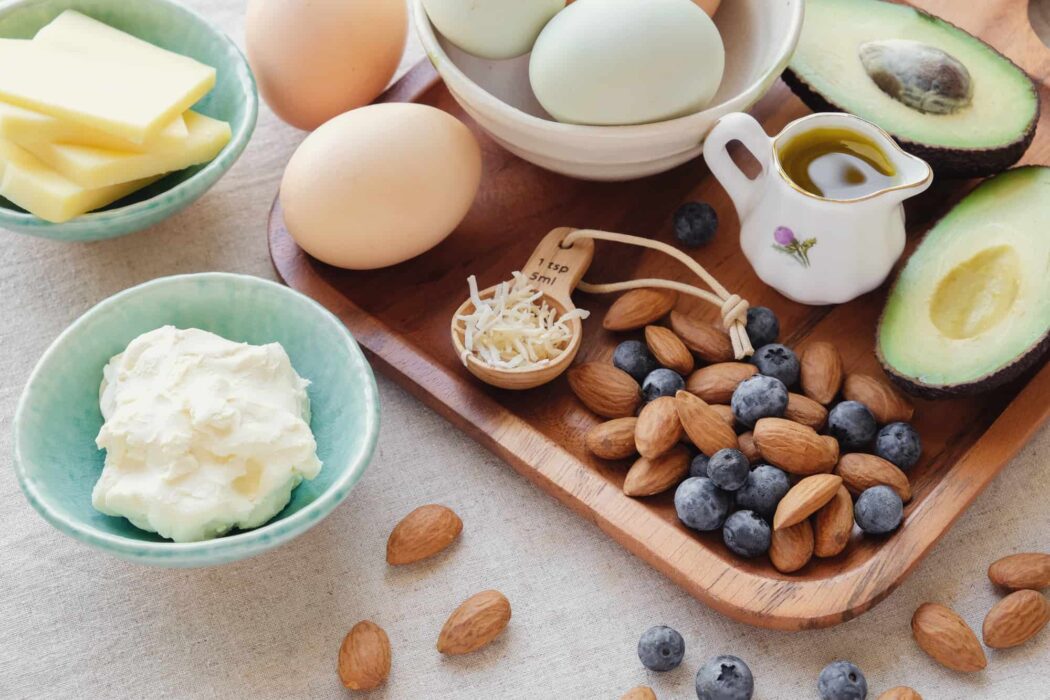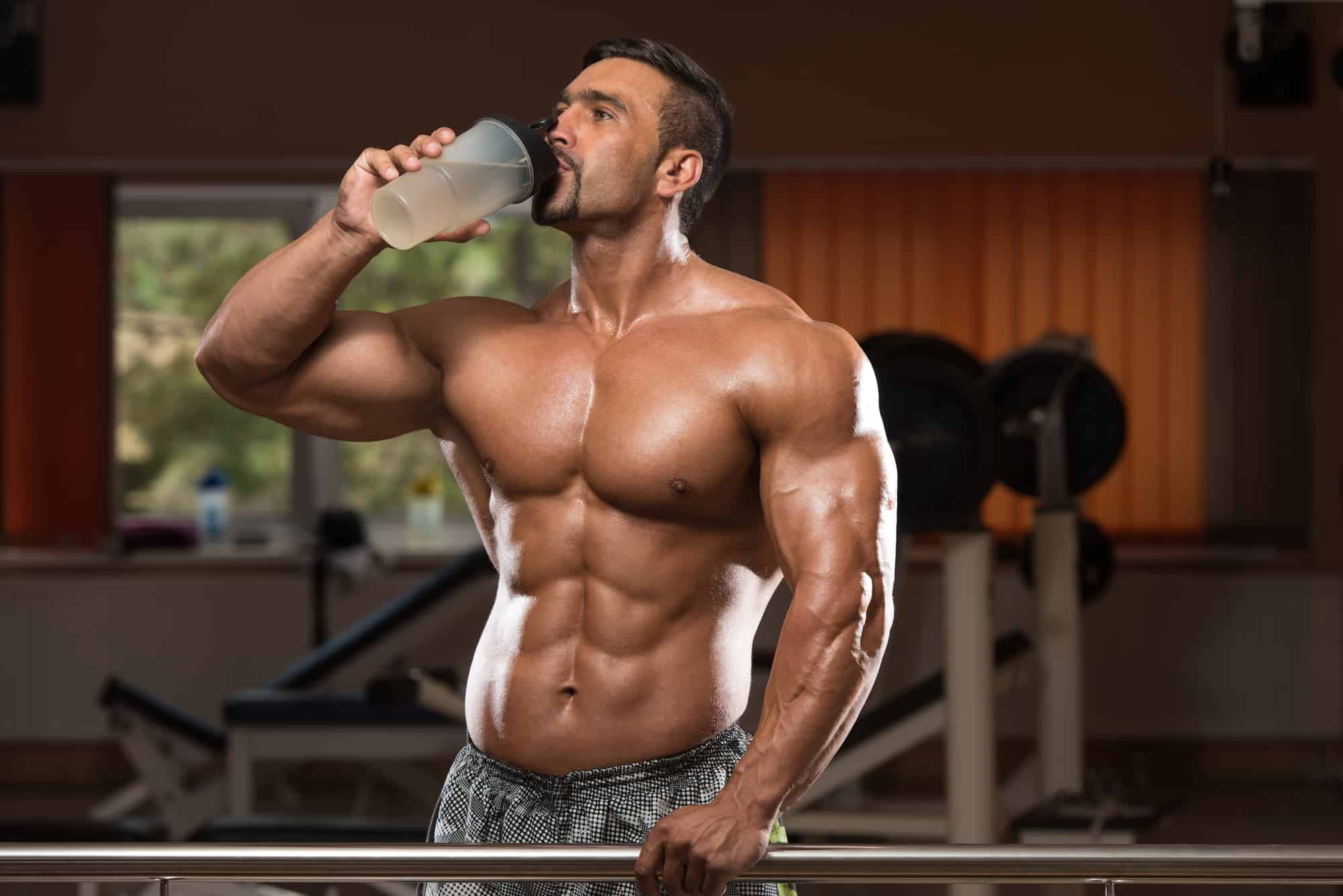The ketogenic diet has become popular over time. It is a carb-restricted diet high in healthy fats used for weight loss and health benefits. People often do not trust this diet because they believe it is impossible to build muscle and get good athletic performance on keto. Carbs consumption is believed to promote the release of insulin. It is an anabolic hormone that helps transport nutrients to the cells, helping create conditions that promote muscle growth. Everyone knows that protein and carbs are necessary for muscle growth. However, is it possible to do strength training without carbs? Can you build muscle on a keto diet?
Contrary to popular belief, you can build muscle on a ketogenic diet. Muscle-building mechanisms work differently on keto than on a high-carb diet. You need to follow a few simple rules and tips if you want to build muscle on a low-carb diet.

How does ketosis affect workouts? It is believed that it gives a lot of strength for exercises that require long-term endurance. But at the same time, ketosis causes some difficulties when you need a powerful burst of energy in a short time. So is strength training possible on keto? How to grow muscles while limiting carbs? Find out everything you need to know about keto and muscle in our keto bodybuilding guide. Let’s dive in!
How Does It Work: Muscles and Insulin
The anabolic properties of carbs are directly related to the activation of the synthesis of certain hormones. Insulin plays the most important role in this process. It is worth noting that proteins also cause an insulin response in the body. Most people know that this hormone regulates blood sugar levels, and when it is low, diabetes can begin to develop. But this is not the only function of this hormone.
Insulin is a multifunctional substance, and one of these functions is participation in creating muscle tissue [1]. For example, one of the tasks of insulin is to accelerate the absorption of amino acid compounds. Simply put, with its help, amino acids from the blood enter the muscle tissues. Therefore, it gives the right to claim that carbs, together with the following insulin response of the body, contribute to muscle mass growth.
How Does It Work: Carbs and Proteins
It should be noted that carbs do not directly participate in the creation of molecule proteins. Instead, the main component of protein synthesis in muscles is an amino acid compound called leucine [2]. For example, this substance is contained in egg yolks.
We can suppose that protein synthesis takes place without the active participation of carbohydrates. So, can you build muscle on a low-carb diet? Naturally, the answer will be positive. However, let’s not rush to conclusions for now and continue to deal with this topic.
Anabolism is often associated with the process of protein production in muscle tissues, which is not correct. Anabolism is the general name for all the processes necessary for muscle mass growth. And for this reason, insulin is an anabolic hormone [3].

The Role of Carbs in Muscle Recovery
Unfortunately, athletes often underestimate the importance of restoring muscle tissue from damages received during training. But after all, the faster the muscles recover, the more often you can work out. The frequency of the training effect on the muscles has a strong influence on the increase in muscle mass.
As mentioned above, carbs contribute to the start of insulin production. It does not lead to increased protein production in muscle tissues, but it prevents their destruction [4]. Thus, thanks to these properties of carbohydrates, they become anabolic. Carbs play a role in the building of muscle tissue, and insulin prevents the destruction of protein compounds and maintains nitrogen balance at the required level. It is also important to remember that muscle tissue recovers faster after training, thanks to carbs.
After intense strength training, the immune system is in a weakened state, and carbs support its functioning. They also help replenish muscle glycogen stores. In this regard, many athletes may have a question: is it necessary to consume carbs immediately after strength training? It all depends on the training process, the frequency of workouts, and the tasks that you set yourself.
If you visit the gym three times a week, there is no point in consuming carbs immediately after completing a workout. It will be enough to digest those carbohydrates that enter the body with food, as they are guaranteed to restore glycogen stores. However, if you’re working out in the gym seriously, eating a couple of bananas after a workout is a must, and it doesn’t matter if you’re consuming other nutrients.
How Does It Work: Creatine and Carbs
Creatine is a must for all athletes who want to build more muscle mass. Moreover, this should be done daily since creatine contributes to the growth of strength indicators and increases the body’s insulin sensitivity [5]. In addition, scientists have found that the combined use of creatine and carbs increases the protein content in muscle tissues.
This fact is easily explained by the ability of insulin to deliver creatine to muscle tissues faster and increase their ability to accumulate it. It is also important to remember that due to insulin, electrolytes accumulate in muscle tissue cells. Together with an increase in creatine levels, it contributes to increased muscle size. Also, due to increased cell hydration and volume, anabolic processes are activated much faster.

Can You Build Muscle on a Keto Diet?
We can confidently assume that carbs are anabolic from all of the above. Even in the absence of a large number of carbs during the keto diet, the body’s anabolic response is present at a fairly high level. The human body is a very complex self-regulating mechanism that, if necessary, makes changes to all processes and adapts to the situation.
When the body does not receive enough carbs, it changes the biochemical rules. The active use of glycogen begins, and the synthesis of hormones is accelerated. It can increase strength and endurance. As a result of all these actions, your body adapts to the lack of carbohydrates and low insulin levels. The body enters a state of ketosis when it has limited access to glucose or carbs, the fuel source that the human body uses for many basic processes. To compensate, our body uses fat to produce ketone bodies as an alternative energy source [6].
Various studies have shown that the ketogenic diet effectively builds muscle mass. For example, a study of 25 college men comparing a high-carbohydrate diet with a keto diet found that both were effective in building muscle mass and strength. A drop in performance and strength during keto is normal and temporary. It is because the body is adapting to dependence on ketones.
What Are the Benefits of Keto Workouts?
When switching to keto, ketone bodies formed from fats become the main energy source. They are spent on most body needs, including giving strength for sports. Many who adhere to the classic ketogenic diet and exercise regularly note the absence of fatigue after training and the willingness to actively move on [7]. It seems that the muscles are ready to work without rest.
The Ultimate Guide to Keto Diet: Foods to Eat and to Avoid
However, this is mostly about cardio workouts or workouts that don’t require bursts of energy for a few seconds when lifting barbells and other high-intensity exercises. In this case, the glycogen stored in the muscles is required as a fast energy source. With a severe restriction of carbs, its reserves are reduced.
On the one hand, it limits the quick compensation of energy, but on the other hand, it has positive aspects. For example, glycogen retains water. So, its reduction will help you get rid of excess fluid. Furthermore, on a low-carb diet, excess fluid and swelling also go away due to decreased insulin production. Therefore, professional athletes and bodybuilders often resort to the ketogenic diet if they want to quickly lose weight from fat and water and improve body composition [8].

What Is the Best Workout on Keto?
On keto, you can quite successfully play sports. Difficulties occur only when your body adapts to a new nutrition style. During this period, you may feel a loss of strength, endurance, and decreased performance. But all this is temporary and passes as soon as the body learns to use ketones for energy.
The keto diet goes well with aerobic exercise. It provides energy for long-term endurance. These include:
- long-distances running;
- low-intensity aerobics;
- cycling;
- racewalking;
- dancing;
- swimming;
- light strength training.
You may experience difficulty with strength training that requires an explosive burst of energy. It is characterized by high intensity and short duration. These include:
- intensive strength exercise;
- CrossFit;
- bicycle race;
- sprint, speed races;
- powerlifting;
- weightlifting.
Why is this happening? The body can use fat as fuel without problems during low-intensity training since the energy requirement is not very high. With a high-intensity workout, you need a lot more. It is easier for your body to use carbs as an energy source, including in the form of glycogen stored in the muscles. After all, they are utilized and processed into energy much faster and easier than fats.
Does this mean you can’t build muscle on a keto diet? Not at all! You just need to know a few simple rules.
How to Perform a High-Intensity Workout on Keto?
High-intensity exercise is effective for building muscle, but you need to either change your exercise routine or deviate slightly from the classic diet option when doing it on keto. When performing strength exercises, a small number of repetitions with long rest periods is recommended [9].
The supply of fast energy in muscle tissue is limited, so its expenditure on training must be constantly compensated. Initially, the body uses the simplest and fastest energy supply system for this. But this system does not function for long. It is enough for a maximum of 2 minutes of intensive workout since the amount of such energy is limited. After it exhausts itself, other energy supply mechanisms begin [10]. It means that for intensive training for more than 2 minutes, carbs will be needed as a quick source of energy. But if after 2 minutes the work of the muscles stops, then the level of fast energy will be restored within a few minutes.
Need Keto Motivation? The Best Tips for Your Keto Lifestyle
Therefore, intense strength training on keto is only possible with a low number of repetitions with long periods of rest for recovery. It is recommended to do up to 6-8 repetitions with breaks of about 5 minutes.
If you still need long, intense, high-rep workouts, then a targeted or cyclical keto diet can be used to provide enough energy. Unlike classic keto, they include an additional intake of carbs, but at the same time, they allow you not to stop ketosis or quickly return to it. This type of nutrition is popular among athletes and bodybuilders.

What is the Cyclical Keto Diet?
Cyclical and targeted ketogenic diets are relatively recent and are mostly used by bodybuilders and athletes. The cyclical keto diet includes 1-2 days per carb loading and consists of two alternating cycles with different ratios of nutrients:
- the first (regular keto) – 75% fat, 20% protein, 5% carbs;
- the second (carb loading) – 25% fat, 50% protein, 25% carbs.
Such a diet helps gain lean muscle mass and burn the remaining fat in the abdomen if followed by intensive training. On loading days, it restores muscle glycogen needed for high-intensity exercise. Eating carbs before a workout or on carb-loading days will give your muscles instant energy [11] they need to explode without reducing the benefits of a ketogenic diet.
However, you should avoid processed foods and refined sugar even while carb-loading. Athletes often make the mistake of allowing themselves fast food and a bucket of ice cream on loading days. Remember that keto is about clean eating, and in the case of a carb-load, it should be natural carbohydrates.
What is the Targeted Keto Diet?
A targeted ketogenic diet (TKD) – allows you to consume additional carbs during short periods of intense training. Often bodybuilders combine it with a high-protein keto diet. The high-protein ketogenic diet (HPKD) contains 60% fat, 35% protein, and 5% carbohydrates.
The targeted keto diet is a compromise between standard keto and cyclical diets [12]. Its essence lies in the increased consumption of carbs an hour and a half before training. This type of keto diet is suitable for people with significant physical exertion, for example, bodybuilders. It is worth noting that you cannot immediately switch to a targeted and cyclical keto diet. The perfect option is to start with a standard keto menu and gradually switch to another type.
A targeted ketogenic diet is most suitable for building muscle mass. It allows the athlete’s body to digest fast carbs within half an hour (one workout). Since athletes perform high-intensity workouts, they can burn additional carbs during one workout. As a result, carbs literally burn out before they can interrupt your ketosis process.
The targeted keto diet is not meant for most gym-goers. However, if you are an easy runner, do cardio 2 times a week, or love yoga, then you should choose a classic ketogenic diet. Thanks to it, you can get the maximum result from training.
To burn carbs quickly while on keto, eat foods that contain easily digestible carbs. To build muscle mass, consume plenty of protein after your workout. Eat 20-50g of high glycemic carbs 30 minutes before it. It allows you to saturate the body with glucose and perform with greater intensity. Ketosis is not interrupted because the additional glucose is completely used for energy for muscle building.

Tips for Gaining Muscle on Keto
If you want to try the keto diet for muscle building, here are some simple tips. I’ve put together the most important advice to help you structure your diet and workouts for the best results. Let’s look at them in more detail.
Determine the Right Amount of Calories
For your body to build muscle, you must consume slightly more calories than you burn. In this sense, the first thing you should do is determine how many calories your body needs per day since this depends on your body composition, height, gender, or activity level. You can use the calorie calculator for correct analyses.
Should I Count Calories on Keto?
To build muscle mass, it is recommended to increase your calorie intake by 15%. For example, let’s say your body needs 2,000 calories per day, then you must increase your intake to 2,300 calories per day to see progress towards your goal. You should slowly increase the number of calories from protein, fats, and healthy carbs during keto to stick to the right keto proportions.
Add More Protein
How to correctly calculate the amount of protein on keto? Proteins are the most important elements for muscle growth. They form the building blocks of muscle tissue, so you need to consume more protein than your body naturally breaks down when trying to build muscle. On a ketogenic diet, its amount is 20 – 25% of the daily calorie content. Is this enough to provide the muscles with the resource they need for growth? Yes. Firstly, on a ketogenic diet, protein is absorbed better. With the exact adherence of the nutrients proportions, the intensity of the formation of glucose from the muscle protein amino acids decreases. It means that this protein is better preserved in the composition of the muscles.
Secondly, it depends on the characteristics of the metabolism of each body. Some people don’t need to restrict protein to achieve stable ketosis. Third, what is 20% protein per daily calorie intake? Let’s say your diet is 2500 kcal, then 500 kcal of them will come from protein. And this is 125 g of pure protein per day. According to the generally accepted recommendations for sports nutrition, it is believed that to build and maintain muscle mass, the daily protein intake should be 1.4 – 2.0 g per 1 kg of body weight [13]. It fits well into the proportions of ketogenic nutrition.
It is advisable to distribute the intake of protein evenly throughout the day. Then, the one-time protein load will be small, and the chances of knocking the body out of ketosis will be less than if you eat the entire amount at a time.

Be Careful with Carbs
To stay in ketosis, many people need to eat a maximum of 50 grams of carbs per day under the condition of heavy physical exertion. Therefore, you may find that tracking your carb intake during workouts can be helpful, especially if you find your performance worsening.
This point is about the cyclical and targeted ketogenic diet. In the case of a cyclical keto diet, you can increase your carb intake to 25% of the daily value for 1-2 days before the workout. In the case of a targeted keto diet, you can consume up to 50 grams of fast carbs an hour before exercise. However, you should not overeat carbs and eat processed food in both cases. The best carb choices to load on keto are many vegetables and fruits that you would normally avoid on keto (like sweet potatoes and bananas). You can also add some rice, corn, and other healthy grains. Don’t forget that you need to slightly reduce the amount of fat and protein before exercising with raised carbs.
Why can’t you carb-load with junk food and ice cream? Increasing the number of carbs involves using metabolic memory for their digestion. Unfortunately, processed food can lead to changes in the gut microbiome and disruption of ketosis later on. In addition, such snacks are difficult to fit into a small number of carbs, and if you overeat, it will take your body more time to reach ketosis again. What’s more, you’ll experience extreme hunger and go through the keto-adaptation process all over again.
Don’t Ignore Nutritional Supplements
We have already discussed nutritional supplements on keto, and you can choose any of them to help your healthy diet. However, if you are considering a heavy keto workout, you should opt for additional protein, electrolytes, and MCT oil. Let me explain why.
Supplemental protein is optional, but it can go a long way toward reaching your goal if you’re having trouble meeting your daily protein needs. You can use a protein powder like whey, casein, pea, or hemp protein. Just watch your carbs.
11 Keto Supplements to Kickstart your Low-Carb Diet
Electrolytes have many benefits for your body. The most important benefits of electrolytes for athletes are muscle building, heart function, and body fluid balance. If you are exercising hard, you need to get extra electrolytes because many of them leave your body with sweat. It’s important to note that many of these powdered supplements contain carbs, so you should read the labels before including them in your diet to keep your body in a keto state.
MCT oil containing medium-chain fatty acids helps you increase endurance for longer exercise. It also promotes entry into ketosis and maintains this state while consuming slightly more carbs. It is especially important if you’re trying a cyclical or targeted keto diet. In addition, many athletes use MCT oil as the healthiest way to quickly increase energy levels.

Be Patient
As I have mentioned earlier, starting a ketogenic diet can cause completely normal side effects for your body as you adjust. But this is not a reason to give up keto. You need to complete the adaptation period. Just try to avoid dehydration, and electrolyte loss, sleep well and be patient to see results.
After adaptation (1-2 weeks), you will feel more energy and be able to return to the previous exercise plan. Train your endurance and choose the right workout plan that will allow you to increase your results. Proper nutrition combined with a targeted strength workout is the key to gaining muscle. Include exercises such as squats, barbell bench presses, and push-ups to stimulate muscle growth.
Conclusion
Exercise on keto requires much more attention than sports during a traditional diet. However, the ketogenic diet is very effective for building muscle mass. Simply following the steps above will help you plan effective nutrition and exercise. Also, contrary to popular belief, it is a completely safe and beneficial method to reach your goal of increasing muscle mass.
The ketogenic diet has many health benefits and goes well with sports, including strength training and muscle building. Although muscle growth may be slower, the breakdown of proteins in the muscles also slows down. If you’ve been into sports for a long time and decide to try keto, first consult with your doctor, nutritionist, and gym coach to create a workout program and nutrition plan based on your goals. In addition to a healthy diet for muscle building, do not forget about healthy sleep and limiting stress.
Sources:
- Dimitriadis G, Mitrou P, Lambadiari V, Maratou E, Raptis SA. Insulin effects in muscle and adipose tissue. Diabetes Res Clin Pract. 2011 Aug;93 Suppl 1:S52-9. doi: 10.1016/S0168-8227(11)70014-6. PMID: 21864752.
- Breen, L., & Churchward-Venne, T. A. (2012). Leucine: a nutrient ‘trigger’ for muscle anabolism, but what more?. The Journal of physiology, 590(9), 2065–2066. https://doi.org/10.1113/jphysiol.2012.230631
- Fujita, S., Rasmussen, B. B., Cadenas, J. G., Grady, J. J., & Volpi, E. (2006). Effect of insulin on human skeletal muscle protein synthesis is modulated by insulin-induced changes in muscle blood flow and amino acid availability. American journal of physiology. Endocrinology and metabolism, 291(4), E745–E754. https://doi.org/10.1152/ajpendo.00271.2005
- Dupuy O, Douzi W, Theurot D, Bosquet L, Dugué B. An Evidence-Based Approach for Choosing Post-exercise Recovery Techniques to Reduce Markers of Muscle Damage, Soreness, Fatigue, and Inflammation: A Systematic Review With Meta-Analysis. Front Physiol. 2018 Apr 26;9:403. doi: 10.3389/fphys.2018.00403. PMID: 29755363; PMCID: PMC5932411.
- Cooper, R., Naclerio, F., Allgrove, J., & Jimenez, A. (2012). Creatine supplementation with specific view to exercise/sports performance: an update. Journal of the International Society of Sports Nutrition, 9(1), 33. https://doi.org/10.1186/1550-2783-9-33
- Valenzuela, P. L., Castillo-García, A., Lucia, A., & Naclerio, F. (2021). Effects of Combining a Ketogenic Diet with Resistance Training on Body Composition, Strength, and Mechanical Power in Trained Individuals: A Narrative Review. Nutrients, 13(9), 3083. https://doi.org/10.3390/nu13093083
- Vargas-Molina, S., Petro, J. L., Romance, R., Kreider, R. B., Schoenfeld, B. J., Bonilla, D. A., & Benítez-Porres, J. (2020). Effects of a ketogenic diet on body composition and strength in trained women. Journal of the International Society of Sports Nutrition, 17(1), 19. https://doi.org/10.1186/s12970-020-00348-7
- Vargas, S., Romance, R., Petro, J. L., Bonilla, D. A., Galancho, I., Espinar, S., Kreider, R. B., & Benítez-Porres, J. (2018). Efficacy of ketogenic diet on body composition during resistance training in trained men: a randomized controlled trial. Journal of the International Society of Sports Nutrition, 15(1), 31. https://doi.org/10.1186/s12970-018-0236-9
- Paoli, A., Cancellara, P., Pompei, P., & Moro, T. (2019). Ketogenic Diet and Skeletal Muscle Hypertrophy: A Frenemy Relationship?. Journal of human kinetics, 68, 233–247. https://doi.org/10.2478/hukin-2019-0071
- Paoli A, Cenci L, Pompei P, Sahin N, Bianco A, Neri M, Caprio M, Moro T. Effects of Two Months of Very Low Carbohydrate Ketogenic Diet on Body Composition, Muscle Strength, Muscle Area, and Blood Parameters in Competitive Natural Body Builders. 2021 Jan 26;13(2):374. doi: 10.3390/nu13020374. PMID: 33530512; PMCID: PMC7911670.
- Kysel, P., Haluzíková, D., Doležalová, R. P., Laňková, I., Lacinová, Z., Kasperová, B. J., Trnovská, J., Hrádková, V., Mráz, M., Vilikus, Z., & Haluzík, M. (2020). The Influence of Cyclical Ketogenic Reduction Diet vs. Nutritionally Balanced Reduction Diet on Body Composition, Strength, and Endurance Performance in Healthy Young Males: A Randomized Controlled Trial. Nutrients, 12(9), 2832. https://doi.org/10.3390/nu12092832
- Shilpa, J., & Mohan, V. (2018). Ketogenic diets: Boon or bane?. The Indian journal of medical research, 148(3), 251–253. https://doi.org/10.4103/ijmr.IJMR_1666_18
- Phillips SM, Van Loon LJ. Dietary protein for athletes: from requirements to optimum adaptation. J Sports Sci. 2011;29 Suppl 1:S29-38. doi: 10.1080/02640414.2011.619204. PMID: 22150425.